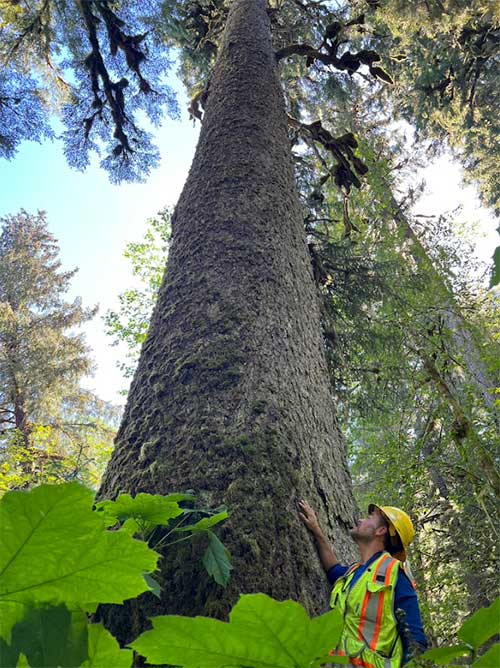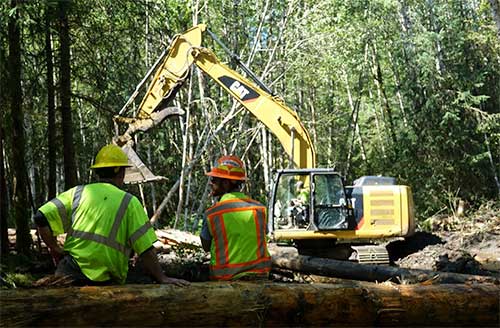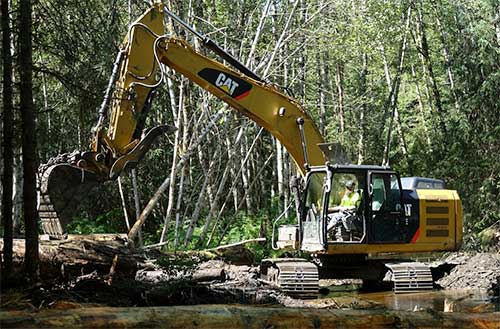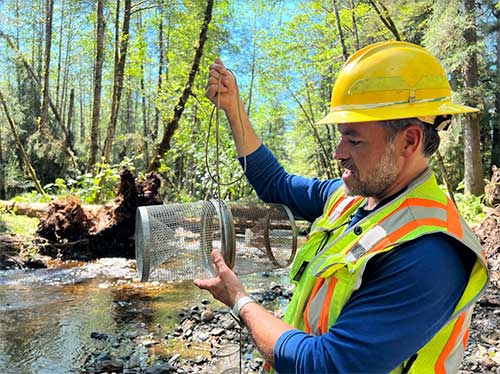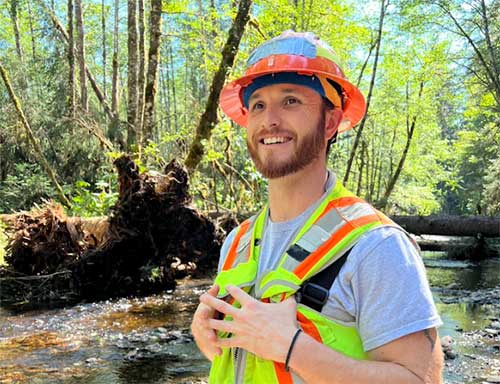
The Salmon StateGrowing “giant pumpkins” and fish habitat in PetersburgBy MARY CATHARINE MARTIN
October 17, 2022
“Those giant pumpkins are what used to grow in this type of environment,” Castro said.
That tree stands in contrast to those that have grown around it over the last 60 years, which have reached four to eight inches in diameter - about a tenth what would once have been expected. Why does the floodplain that grew some of the largest trees left on Mitkof grow stunted trees now? It’s a mystery that, when he first came across it, Forest Service hydrologist Heath Whitacre was determined to get to the bottom of. After talking to Petersburg old-timers, he learned the reason wasn’t just because the area was clearcut around 60 years ago. It’s because when workers extended Mitkof Highway in the 1950s, they took gravel from the rich soil of the area, depleting the nutrients. This also lowered the ground level to the point it was too close to the water table for trees to grow well. Logging and gravel mining also had negative implications for fish, straightening streams and eliminating or lessening the fallen trees, deep pools and rich back-channel floodplain habitat that can be so productive for rearing salmon fry. A few years ago, Whitacre, Castro and the Petersburg Ranger District began putting together a project not only to restore fish habitat in East Ohmer Creek, but to gradually replenish soils, restore floodplain flows, and bring the area back to what it was prior to the gravel mining and logging of the 1950s. “It kind of rights our wrong from the past,” Castro said. It’s also a project that, while it was completed this summer, has a much longer-term vision. “Soil formation is a centuries-long process,” Whitacre said. Big machine, little fish While the timeline for bettering growing conditions for trees and restoring the area to its former “giant pumpkin” glory may be centuries, fish habitat in the area is already improving. Excavator operator Tom Lutton of Rock-N-Road Construction in Petersburg was a skeptic when he first started working on East Ohmer Creek restoration. By day two, he was a convert. “This is the first time I’ve ever done one of these projects, and I didn’t really understand it beforehand. After being down in there and seeing exactly what they’re doing, I figured it all out,” he said.
The second day, after the heavy equipment crew had placed some trees according to Whitacre’s sketch, “I got down in there and I could see those certain pools, even though we didn’t get any rain, they actually had deeper water in them than they did the day before,” Lutton said. Lutton has lived in Petersburg for 54 years - since he was six years old - and said it feels good to be working to improve the fish habitat in East Ohmer. “I feel personally that the fish runs in this creek have slowed down since I was younger, and I think stuff like this only improves it,” he said. While many small-creek restoration projects across Southeast Alaska utilize human muscle and hand tools, the scale of the East Ohmer Creek project meant larger tools were necessary. For the first few years at least, it will look messy. “The footprint with heavy equipment tends to be shocking to some people,” Whitacre said. “And it basically looks like a construction site, and it will for four or five more years, until we start to get more vegetation. But the amount of work you can get done in a short period of time is astounding. And basically when you’re working in a stream this size, you need a larger framework in place, and it’s really the best way to do that.”
Some of what people see might not make sense until it starts making a difference. The trees in the floodplain, for example, will serve as nurse trees for seeds and saplings, raising the ground level higher over the water table and nutrient-poor soil. Those trees will also help capture soil washed down from upstream when the area floods. Over the long-term, they’ll speed up the process of restoring the area to what it once was. In addition to the deeper rearing pools in the main channel, some of the team’s other goals are already coming into play. Off-channel rearing ponds, said Castro, are like beaver ponds in that they are ten times more productive for salmon fry than even high quality main channel habitat. In late July, as the project was nearing completion, Whitacre and Snyder walked up a channel that had been dry prior to them adding wood to the system to divert water into it during heavy rain. Now, it was filled with refuge-like pools - and those pools were filled with coho salmon fry. “These little pools that they find are where they’re going to hang out until the next bit of water comes in,” Whitacre said. “Even creating a little bit of habitat that establishes a few deep pools in an otherwise dry channel, those are basically refuge areas for these fry until they can get another flow through.”
Prior to work in any back channel rearing ponds, Castro, Whitacre and VetsWork intern Taran Snyder moved hundreds of fish fry using minnow traps. (In main channel areas, fish more easily relocate themselves.) They also did all the work in East Ohmer Creek in a relatively small one-month window, so as to avoid overlapping with spawning seasons — whether at the front end of the season, with steelhead, or the back end, with coho salmon. A short while after finding coho in the newly watered back channel, Snyder, Whitacre and Castro were watching Rock-N-Road operator Jode Coil lower an enormous tree trunk, rootwad intact, into place precisely where Whitacre had drawn it should be. Just twenty minutes later, Coil moved his excavator fifty feet downstream. The water cleared, and a six-inch cutthroat trout and coho fry held steady in the current, facing upstream. It wasn’t at all apparent there had been a heavy machine in the area just a few minutes before. “Habitat restoration is an essential element of being able to support sustainable (fish) populations,” Castro said. “In order for us to have the maximum amount of fish potential, be it for sport fishermen, or commercial fishermen, subsistence, we need to be able to have healthy landscapes.” Long-term restoration needs This project fits well with the U.S. Department of Agriculture’s new Southeast Alaska Sustainability Strategy, Whitacre said. Ongoing restoration needs in the region also mean continued jobs — for fallers cutting trees that will be added to oversimplified streams; for heavy equipment operators on larger-scale projects; for the crews that do the work. “Now is kind of a special time with sort of a shift in priorities on the forest. And restoration and recreation have become more important, and are receiving more funding. So it’s not as difficult as it used to be to fund these projects,” Whitacre said. (See the end of the article for a list of this project’s funders.) Lutton said he would love to do more of this work. “I thoroughly enjoyed it,” he said. “In my own free time I love to be out in the woods, I love to be on the water. So getting out of town and not working in people’s yards, not working on streets, this was a real treat for me. To be out in the woods all day. It’s what I like to do. I’m also getting paid for it, so it’s a double bonus.”
Taran Snyder, an Army veteran living in Petersburg and participating in the restoration as part of his time with VetsWork, which provides career development for veterans, said one of the things that stood out the most to him about this project was people coming together from different backgrounds to work on this common goal. “You don’t just have to be from one straight walk of life to contribute to restoration of an ecosystem,” he said. “We are all doing the work, making sure that this place gets restored for the betterment of the next generation.” “Bang for the buck, stream restoration is where it’s at,” Castro said. “It utilizes local citizens in order to be able to do the work, it creates an environment that is conducive to happy fish, and it creates potential swimming holes for happy kids. So that’s something that we would like to see more of.” The U.S. Forest Service, Southeast Alaska Watershed Coalition (SAWC), Alaska Sustainable Salmon Fund (AKSSF), and the Petersburg/Wrangell/Kake Resource Allocation Committee (RAC) all funded the East Ohmer Creek restoration project; the watershed coalition also provided on-the-ground people power. Sitka Conservation Society and SalmonState provided non-monetary support. VetsWork is a program of Mt. Adams Institute, a 501c(3) non-profit. It is funded by AmeriCorps and provides career development internships for veterans through partnerships with natural resources/public lands management agencies and organizations in Alaska and across the country.
Representations of fact and opinions in comments posted are solely those of the individual posters and do not represent the opinions of Sitnews.
|
||||||||
